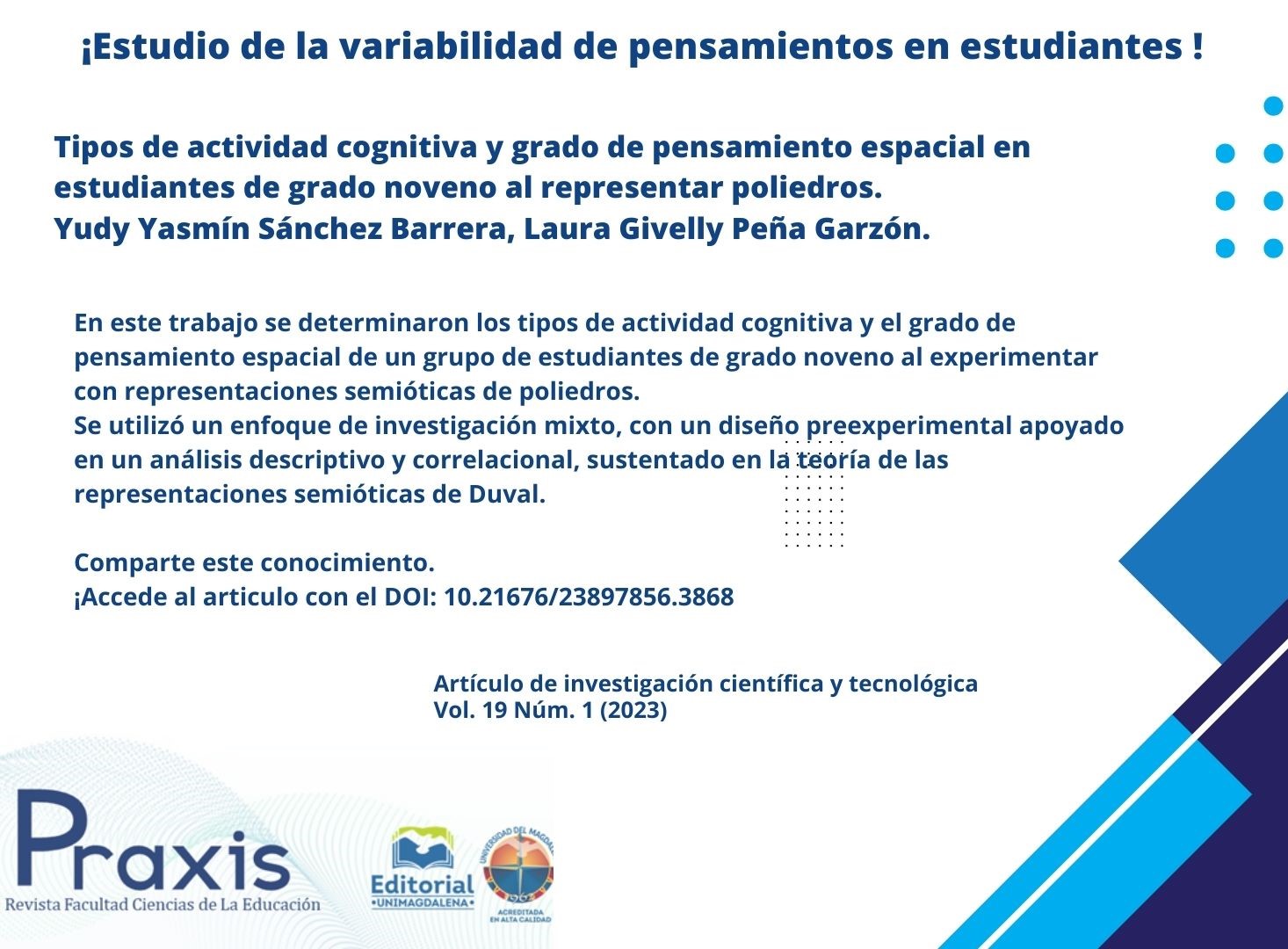Abstract
Spatial thinking is one of the central axes of the study of geometry, which occupies an important position in the curriculum at different educational levels. In this paper we determine the types of cognitive activity and the level of spatial thinking of a group of ninth year students in their experience with semiotic representations of polyhedra. Their definitions of prism and pyramid were compared with those given by a group of first-semester undergraduate students in Mathematics. This comparison lead us to analyse the way these objects are presented in textbooks and websites. A mixed research approach was used, with an action research design, supported by Raymond Duval's theory of semiotic representations. The analysis of the tests determined difficulties in the use of verbal language when describing polyhedra and a low level of spatial thinking to transform a 3D figure. It was also found that there is no significant difference in the conceptions of 3D objects given by the two groups of students. Part of this confusion was attributed to errors present in some textbooks and websites.References
Arcavi, A. (2003). The role of visual representations in the learning of mathematics. Educational Studies in Mathematics, 52(3), 215-241.
Baloco, C., & López, O. (2022). Ambientes virtuales con metodología de aprendizaje basado en problemas (ABP): Una estrategia didáctica para el fortalecimiento de competencias matemáticasde las herramientas multimedia interactivas para la enseñanza. Praxis, 18(2), 324-334.
Behar, D. S. (2008). Metodología de la investigación. Shalom.
Blanco, H. (2009). Representaciones gráficas de cuerpos geométricos. Un análisis de los cuerpos a través de sus representaciones [Tesis de maestría en Ciencias en Matemática Educativa, Instituto Politécnico Nacional, México].
Buenaventura, J. (2015). Representaciones semióticas de sólidos que tienen los estudiantes de educación media [Trabajo de grado, Universidad del Tolima].
D’Amore, B. y Fandiño, M. (2012). Análisis de situaciones de aula en el contexto de la práctica de investigación: un punto de vista semiótico. Educación Matemática, 24(3), 89-117.
Díaz, R., Robayo, M., Díaz, F., Centeno, G., Torres, M. y Quijano, M. (2004). Nuevo Pensamiento Matemático 7. Libros y Libros.
Duval, R. (1999). Representation. Vision and visualization: Cognitive functions in Mathematical Thinking. Basic Issues for Learning.
Duval, R. (2006). A cognitive analysis of problems of comprehension in a learning of mathematic. En R. Duval, Educational Studies in Mathematics (pp. 103-131). EBSCOhost.
Duval, R. (2017). Understanding the Mathematical Way of Thinking-The Registers of Semiotic Representations. Springer Nature.
Duval, R. y Sáenz-Ludlow, A. (2016). Comprensión y aprendizaje en matemáticas: perspectivas semióticas seleccionadas. Universidad Distrital Francisco José de Caldas.
ECME17. (2018). Programación General ECME-17. Lineamientos curriculares y estándares de matemáticas: Investigación e innovación en el aula. http://www.asocolme.org/images/eventos/17/programacion-ecme17.pdf.
Ernest, P. (2006). A Semiotic Perspective of Mathematical Activity: The Case of Number. Educational Study in Mathematics, 61(1/2), 67-101.
Esquivel, A. (2018). Propuesta didáctica para fortalecer la habilidad de abstracción en el aprendizaje de sólidos geométricos con estudiantes de grado noveno [Tesis de maestría en Enseñanza de las Ciencias Exactas y Naturales, Universidad Nacional de Colombia]. Repositorio Institucional. https://repositorio.unal.edu.co/handle/unal/69583
Grupo Pedagógico. (2020). Taller Dinámico 3 Tercero. Dinámico Pedagogía y Diseño.
ICME14. (2021). Topic Study Groups. Proceedings of the fourteenth International Congress on Mathematical Education (ICME14, July 11 – 18, 2021). Shanghai. https://www.icme14.org/static/en/news/37.html?v=1570521982227
Jankvist, U. T., Van den Heuvel-Panhuizen, M., & Veldhuis, M. (Eds.). (2019). Proceedings of the Eleventh Congress of the European Society for Research in Mathematics Education (CERME11, February 6 – 10, 2019). Utrecht, the Netherlands: Freudenthal Group & Freudenthal Institute, Utrecht University and ERME. https://hal.science/CERME11
MEN (1998). Lineamientos curriculares en Matemáticas. Ministerio de Educación Nacional. Colombia. https://www.mineducacion.gov.co/1621/articles-89869_archivo_pdf9.pdf
MEN. (2006). Estándares Básicos de Competencias en Matemáticas. Ministerio de Educación Nacional. Colombia. https://www.mineducacion.gov.co/1621/articles-116042_archivo_pdf2.pdf
MEN. (2016). Derechos básicos de aprendizaje. Ministerio de Educación Nacional. Colombia. https://www.colombiaaprende.edu.co/sites/default/files/files_public/2022-06/DBA_Matematicas-min.pdf
Mizzi, A. (2017). The Relationship between Language and Spatial Ability. Springer Spektrum.
Radford, L. (2006). Algebraic thinking and the generalization of patterns: A semiotic perspective. PME-NA 2006 Proceedings, 1-2, 2-21.
Sampieri, R. H. (2018). Metodología de la investigación: las rutas cuantitativa, cualitativa y mixta. McGraw-Hill.
Sancho, M. (2018). Maths Activity Book Primary 4. Stanley Publishing.
Suárez, P. y Ramírez, G. (2011). Exploración de sólidos a partir de sistemas de representación. Praxis & Saber, 2(3), 27-60. https://revistas.uptc.edu.co/revistas/index.php/praxis_saber/article/view/1109
Toro, D. A. (2017). Redescubrimiento de la geometría mediante el desarrollo del pensamiento espacial y la interpretación del mundo físico en los estudiantes del grado sexto de la I.E. Santa Rita Sede Santa Ana [Trabajo de grado para optar al título de magíster en Enseñanza de las Ciencias Exactas y Naturales, Universidad Nacional de Colombia, Manizales, Colombia]. Repositorio Institucional. https://repositorio.unal.edu.co/handle/unal/59208
Wai, J., Lubinski, D. y Benbow, C. P. (2009). Spatial ability for STEM domains: Aligning over 50 years of cumulative psychological knowledge solidifies its importance. Journal of Educational Psychology, 101(4), 817-835. https://doi.org/10.1037/a0016127

This work is licensed under a Creative Commons Attribution-NonCommercial-ShareAlike 4.0 International License.
Copyright (c) 2023 Praxis

